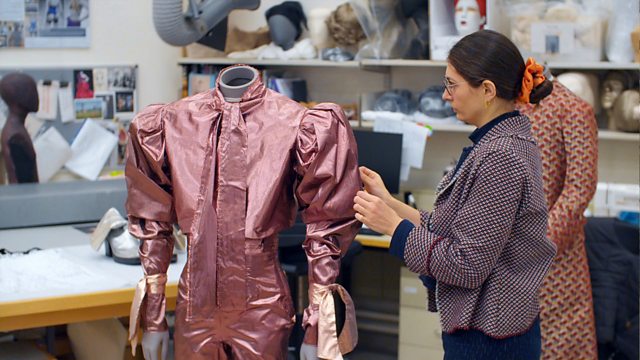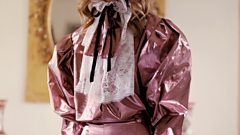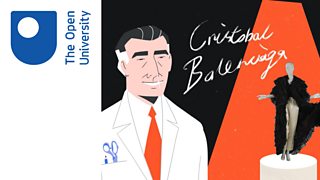
Episode 3
At the V&A, curators must display the museum’s biggest-ever object, a bionic hand arrives and secrets of artist Eric Ravilious’s work for the Wedgwood company are uncovered.
Inside every museum is a hidden world, and now cameras are returning to the V&A, going behind the scenes to parts of the Victoria and Albert Museum never seen before.
Only a small fraction of the museum’s enormous collection is on display. But in this series, we’ll go behind closed doors, discovering the painstaking work of the V&A’s experts as they breathe new life into fragile marvels, uncover hidden stories and preserve the best of past and present.
This year, the V&A is being transformed – with new museums on the way, and more of its treasures than ever travelling to every part of the UK. In this series, we’ll find out how the V&A puts the biggest object it has ever acquired on display, hear the surprising tales of some of its Scottish collection and unearth the human stories behind the objects in their blockbuster shows, from Beatrix Potter’s original drawings to 21st-century fashion. We’ll see rare works by artists from Donatello to Constable, uncover the secrets of Tommy Cooper’s magic tricks and meet the woman painted by renowned contemporary artist Kehinde Wiley.
This week, extraordinary new works of cutting-edge design are arriving at the museum. The V&A is planning its biggest-ever menswear exhibition, and curator Rosalind has just taken delivery of a new ensemble for the show. It’s a shiny pink lamé two-piece, made in 2017 by acclaimed young fashion designer Harris Reed, that comes complete with a cigarette burn from its past life as a party outfit.
For the new show, Rosalind is planning to pair Harris’s outfit and others with historic works of art that together will reveal how menswear has reflected changing ideas about gender down the ages. Harris Reed is a designer interested in gender fluidity, and his outfit – made to measure for himself - is in shocking pink, not a colour much associated with men in recent years. But in the past, pink was a badge of wealth and success for both sexes. Rosalind invites Harris to the National Gallery in London, where they come face to face with Jacques Cazotte, an 18th-century French colonial administrator who sat for his portrait wearing a pink silk outfit bearing striking similarities to Harris’s 2017 ensemble.
In east London, a giant new outpost of the V&A is under construction. When V&A East Storehouse opens in 2024, visitors will be able to walk amongst some of the V&A’s treasures previously hidden away in storage. But the building will also house new pieces. The museum has recently acquired its biggest-ever object, and now the team wants to display it in the middle of the Storehouse.
The new acquisition is a giant ten-tonne slice of a tower block from an east London council estate known as Robin Hood Gardens. This monolith of modernism was designed by the famous husband-and-wife architects Peter and Alison Smithson and completed in 1972. Robin Hood Gardens is being demolished, but the V&A stepped in to acquire several large chunks of the façade. Now they hope to reassemble these giant concrete components inside the new Storehouse and hang the entire edifice 15 metres in the air. If the hugely ambitious plan is a success, visitors will be able to get a sense of the estate’s most famous feature – the ‘streets in the sky’, which the Smithsons hoped would replicate the terraced streets of the old East End.
The V&A’s old Museum of Childhood is also undergoing a major revamp – it’s being transformed into a new museum to be known as Young V&A. But even while the site is closed for its makeover, curators are still acquiring new pieces, with many embodying cutting-edge design. Curators Kristian and Trish have just acquired a bionic arm, a robotic prosthesis made from 3D-printed plastic and designed to help children and young people with disabilities. The Hero Arm, as it’s known, was created with input from young people themselves. Trish goes to meet 16-year-old social media influencer Tilly to find out how she’s contributed to the bionic arm’s special features.
At the V&A’s Wedgwood Collection in Stoke-on-Trent, archivist Lucy and curator Catrin are taking delivery of a mid-century treasure that shows off the Wedgwood company’s tradition of working with the most cutting-edge artists of their day. Eric Ravilious’s travel tea set, which went into production in the early 1950s, celebrates planes, trains and hot-air balloons, amongst other forms of transport. Ravilious designed the set in 1938, but production was put on hold when the Second World War broke out. Ravilious himself became a war artist during the conflict, but in 1942 he failed to return from an RAF mission over Iceland.
Today, Ravilious’s granddaughter Ella, who herself works as a curator for the V&A, is writing a new book about her grandfather, whose reputation has grown and grown in recent years. Ella travels to Stoke to see the Wedgwood factory’s closely guarded pattern books, which reveal the top-secret process by which Ravilious’s designs became a mass-produced tea set.
Last on
More episodes
Previous
Next
Clip
-
![]()
A pink lame ensemble designed and worn by Harris Reed
Duration: 01:01
Credits
| Role | Contributor |
|---|---|
| Executive Producer | Alistair Pegg |
| Executive Producer | Sacha Baveystock |
| Series Producer | Paula Fasht |
| Series Editor | Paul Golding |
| Director | Jonny Ashton |
| Director | Ed Venner |
| Producer | Harry Pick |


